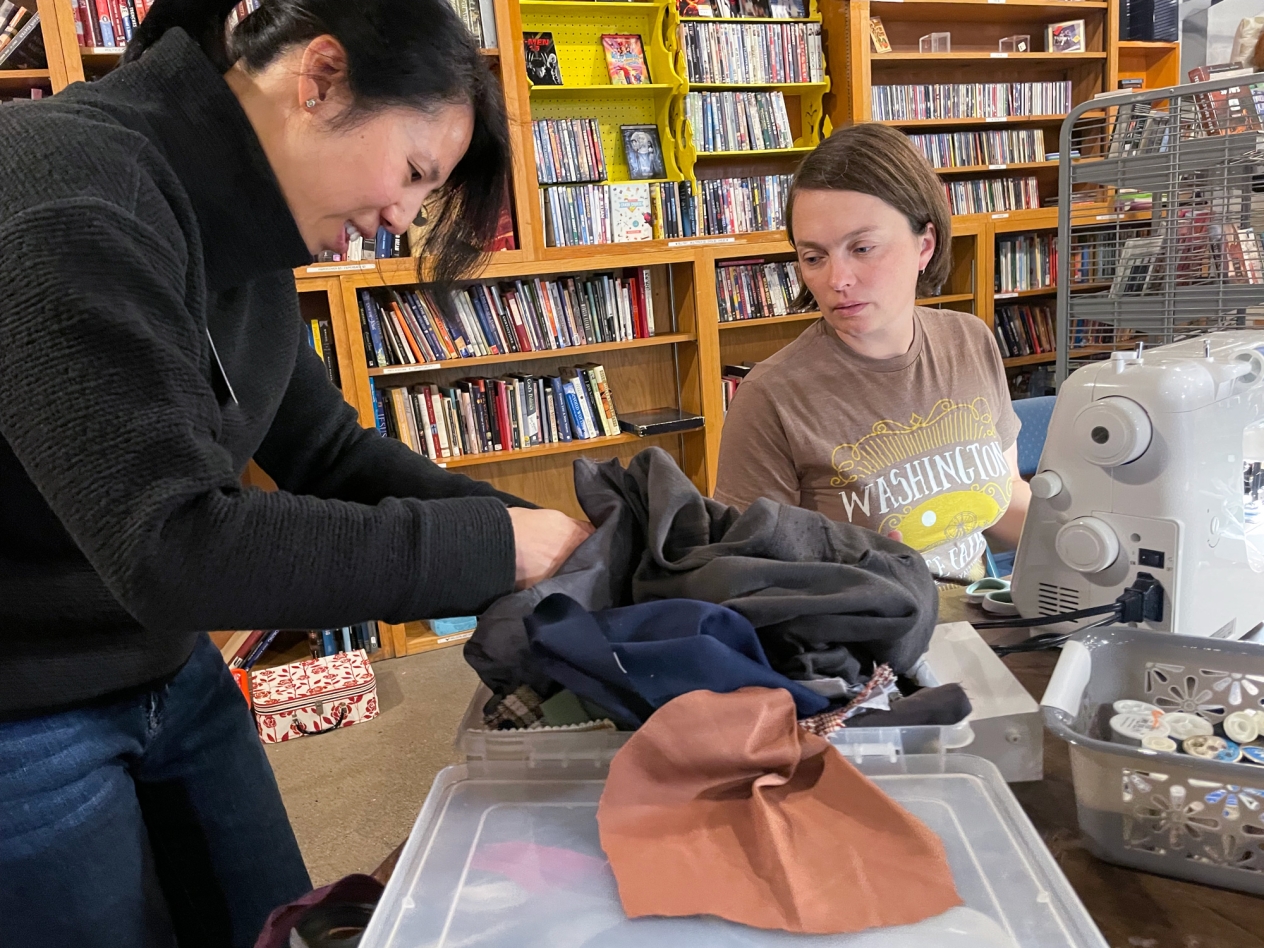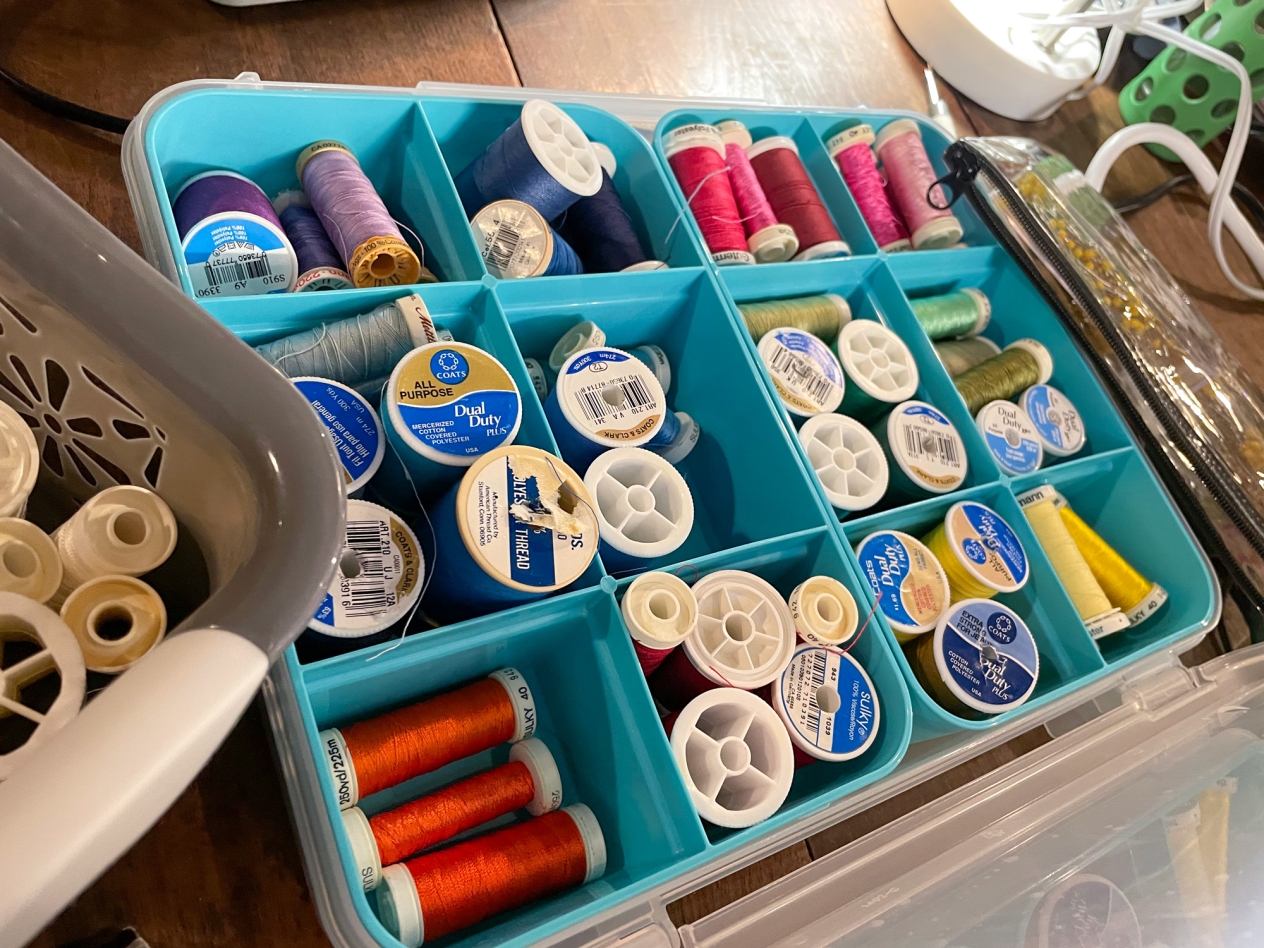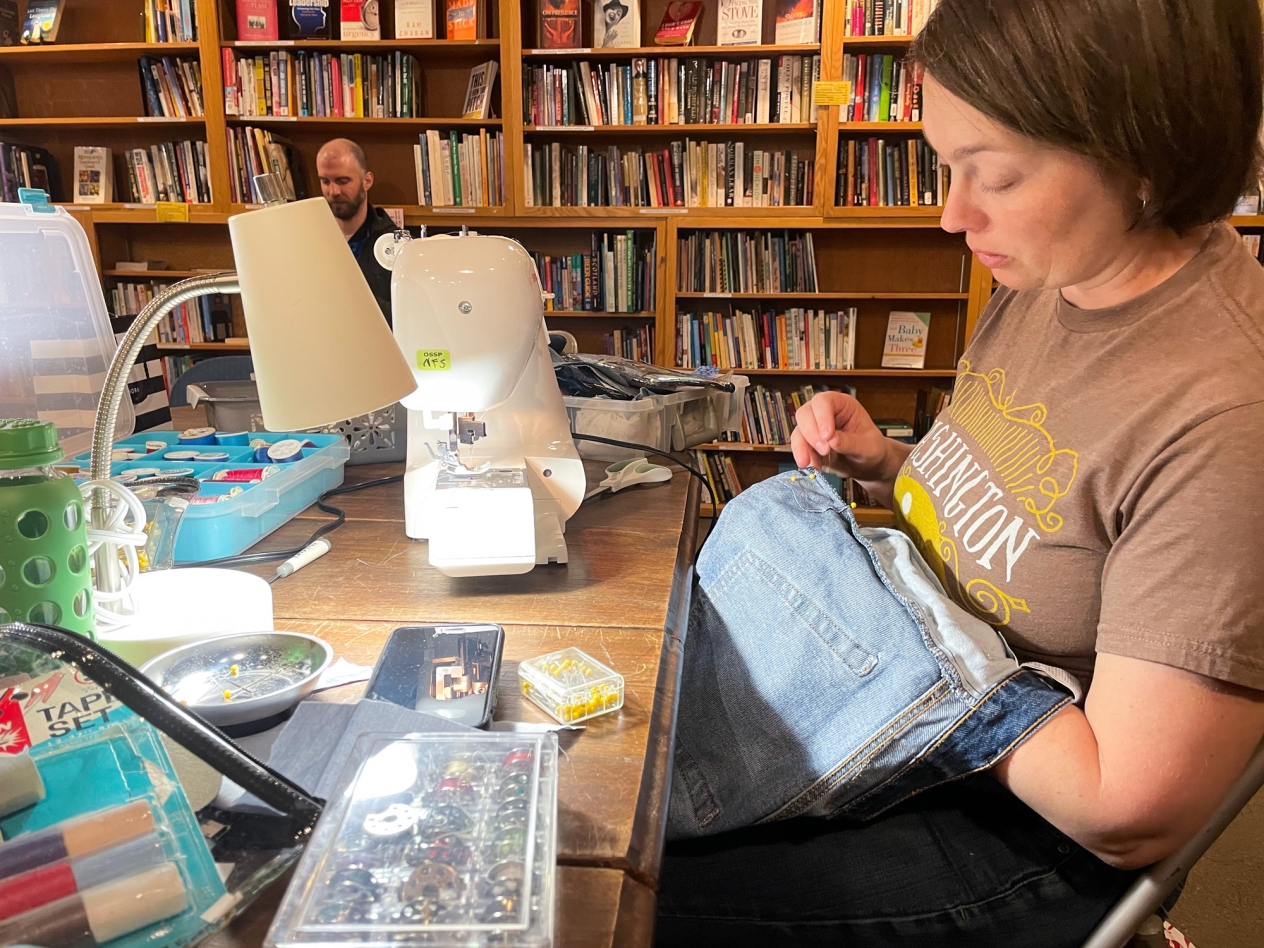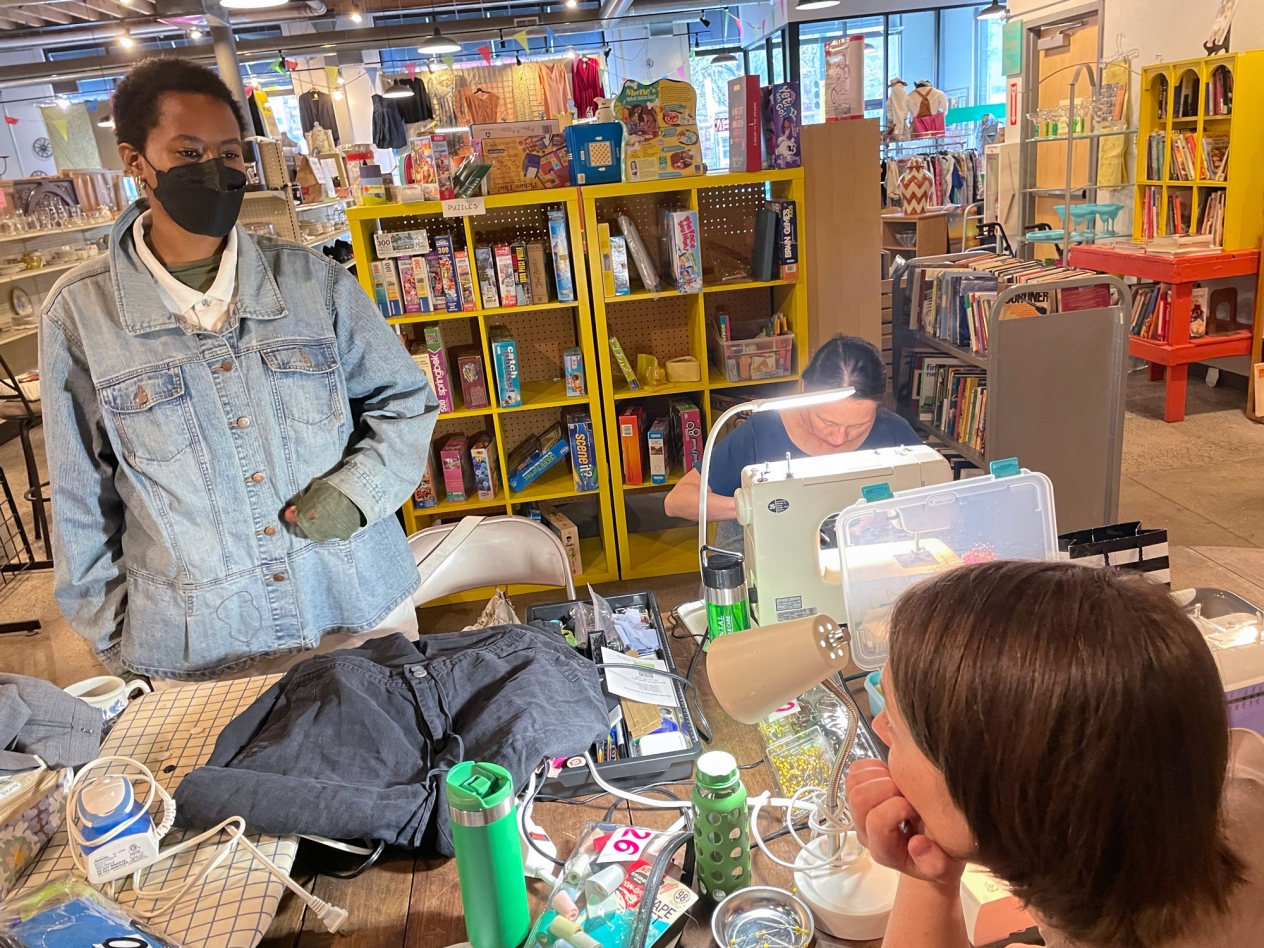
To counter excessive production and textile waste from fast fashion, MPCA steps up funding for reuse and waste reduction projects
As the spring rain pitterpatters outside a Minneapolis thrift shop and an Ella Fitzgerald song plays softly over its speakers, the hum and buzz and tap and snap of sewing machines emanates from one corner of the shop.
Around an old wooden dining table and among stacks of dog-eared books, three stitchers from Reuse Minnesota sit at the sewing machines, fixing zippers, patching rips, and replacing popped buttons. They occasionally stop to withdraw the jeans or shirts from the bright white glow of their work lamps to show their progress to the owners of the apparel at hand.
While the three work one of the non-profit organization’s mend-it clinics with the ostensible goal of saving clothes from the landfill, they also have a broader goal of getting people to think about what they can do to extend the useful life of the things they already own through repair and reuse.
“If we talk them through the process and show the way things work, then they know that these things can be fixed,” says Emily Barker, the executive director of Reuse Minnesota, as she’s installing a reinforcing patch along the seam of a pair of jeans. “That’s a lot of what we’re up against.”
That and stuck zippers.
Putting reuse to use at mend-it clinics
Reuse Minnesota recently added the series of mend-it clinics to the organization’s schedule of events with help from a grant from the MPCA. The $46,000 grant not only allowed Reuse Minnesota to pay the menders who staff the clinics, it also allowed the organization to put on free classes showing how to repair and reuse clothing and to pay menders to repair clothing donated to Old School, the thrift shop in the Stevens Square neighborhood that sets aside a table and a corner for the clinics.
The grant also covers supplies for the mending clinics, though that doesn’t mean Barker stocked up on new thimbles and thread.
“We get a lot of supplies secondhand or donated from local Buy Nothing groups,” she says. She surveys the small bins and totes holding thread and bobbins and other sewing supplies that take up the table’s surface. The clothing iron came from an estate sale, the tin full of buttons came from her own stash, and some of the thread came from a garage sale at Minneapolis’s Textile Center. “We’re trying to live up to our mission of reuse while doing this.”

Similar to the fix-it clinics to which people can bring a wider variety of household items for repair — everything from toasters and stereos to window screens and lamps — that are well-established in the Twin Cities metro area, mend-it clinics focus exclusively on fixing clothes for anybody who'd like to get a few more years out of the garments in their closets.
Barker said she chose to focus on textiles and mend-it clinics for this grant because textiles make up such a large part of the waste stream.
“While there are many local upcyclers who repurpose damaged clothes, it’s hard to verify that textile recycling markets are actually recycling textiles,” Barker says. “We want to increase the amount of stuff that gets repaired and reused so we don't have to rely on recycling.”
The rise of “fast fashion” — that is, inexpensive, low-quality clothes rapidly produced to meet changing trends then worn once or twice and discarded — has contributed to a steep increase in textile waste. One widely quoted statistic from 2017 claims 92 million metric tons of textile waste are generated globally every year. Another claims that the United States alone generates enough textile waste to fill the Mall of America every six days.
The big problem with textile waste
In 2018, the U.S. Environmental Protection Agency estimated textile waste at more than 17 million tons per year, almost twice what was generated in 2000. Of that amount, just 2.5 million tons are recycled, compared to the 3.2 million tons put in incinerators at waste-to-energy facilities and the 11.3 million tons that end up in landfills.
The MPCA doesn’t collect data on how much of the state’s waste stream consists of textiles, but by looking at how much clothing and other textiles has appeared in municipal solid waste in previous studies versus the total amount of waste in the state, it can estimate that 134,000 to 192,000 tons of textiles are thrown out. Of that amount, 8,168 tons goes to recyclers.
But that total amount is just a rough estimate, and neither the EPA nor the MPCA know for sure the total environmental impact from textile waste.
“It’s a big unknown,” according to Susan Heffron, an MPCA recycling market development coordinator. “Businesses are not required to tell us if they recycle textiles and where it goes.”
Much of the textile waste and recycling industry is managed by brokers, which may sell old clothes to thrift and secondhand stores or which may sell them to be turned into wipes or other absorbents.
“The assumption is most of the textile waste is being sent overseas,” says Annika Bergen, a senior state program administrator for the MPCA. “This is not only difficult to track, but also concerning on so many levels for the United States to be sending unwanted clothing to other countries.”
Funding boost for reuse programs
Fix-it and mend-it clinics and other efforts to keep easily repaired items from entering the waste stream are nothing new, especially in the metro area. Counties, colleges, and nonprofits in the metro area run regular clinics while local businesses like Repair Lair and Free Geek specialize in returning used items needing a little TLC to retail shelves.
As with data on total textile waste and recycling, data on how much clothing and other textiles gets reused is scant: Counties in Minnesota are not required to report textile reuse amounts, but those that do reported about 3,000 tons of textiles resold or repaired in the state every year, largely in the metro area.
To increase that amount, the MPCA is putting more money behind programs that expand reuse for products and materials, including textiles, and minimize other waste. In 2022 and 2023, the MPCA used its annual Environmental Assistance grant program to put the spotlight on waste reduction and reuse efforts.

In addition to funding Reuse Minnesota’s mend-it clinics, the $139,000 that the program distributed in 2023 also helped expand Roundtable Rx’s program that redistributes otherwise wasted medications and expanded funding for Minnesota Waste Wise's MNimize program that reduces single-use disposables at restaurants. The 2022 grants helped fund a Dakota County initiative to reduce disposable items in school cafeterias, a series of mobile bike repair clinics and fix-it cafes in Carver County, tool repair for the Minnesota Tool Library in the Twin Cities, and an internship program at Minnesota Tech for Success.
Perhaps just as significant were the projects that didn’t get funding. According to Bergen, the MPCA received requests totaling more than $600,000 in 2022 and nearly $1 million in 2023.
“Both rounds confirmed there’s statewide interest in waste reduction and reuse and a clear demand for more state funding and support,” she says.
As a result, the MPCA used these two rounds of Environmental Assistance grants and the lessons learned from them to shape how it will distribute one-time funds from the 2023 Legislature for additional statewide waste reduction and reuse grant projects. Applications are under review for a first grant round, with another round slated for later this year.
A new life for old clothes
With its grant, Reuse Minnesota started its mend-it clinics in January with three to four people working each clinic.
“We do have a couple of volunteers helping us, but being able to pay people and not rely on volunteers recognizes the people who have these valuable skills and still allows us to offer these events for free to the community,” Barker says.
So far, the clinics have mended 129 pounds of clothes, bags, curtains, and even a few stuffed animals. Each article of clothing is weighed when it comes into the clinic so Reuse Minnesota knows how much it’s kept out of landfills with the program. The most common requests are for altered pants hems so that people can reuse clothes that don’t exactly fit them. The most challenging, Barker says, are zippers.
“A full replacement is a big deal,” she says as another mender, Mai, works on a bag requiring just such a repair. “Zippers are so embedded in fabrics, you often end up needing to repair multiple layers. Sometimes we’ll just cut away the teeth and stitch the new zipper to the old one.”
Barker expects more need for repairs as spring cleaning picks up and as summer outfits emerge from winter storage. “Winter clothing’s usually more durable,” she points out. “Summer clothing less so.”

The MPCA grant money will help cover the costs of the mend-it clinics through the summer of 2025, but the clinics are also just one of multiple programs Reuse Minnesota conducts to reduce textile waste. One of the classes the grant helped fund focused on repurposing old button-down shirts into gift wrap — opened not with the crinkle of paper to be disposed of right away but with the careful unbuttoning of a beloved shirt.
The organization also has a grant from Hennepin County to teach mending and reuse techniques to high school students, and later this year Barker intends to use funds from another grant to offer fix-it clinics in Greater Minnesota.
In the meantime, though, Barker puts the finishing touches on the repaired jeans and turns to help somebody else decide which buttons from her tin will look best on a pair of slacks. They decide on a couple slate gray buttons and a course of action.
“Can you sew one on, then I’ll sew the other?” the owner of the slacks asks.
“Of course,” Barker says. Then they get to work.
